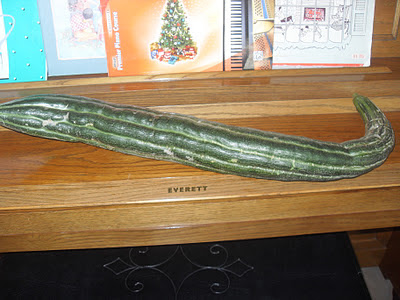 |
| Painted Serpent plant growing in a pot lowered in the ground |
Imagine a succulent hothouse cucumber just brought from the grocery store. Envision that cucumber with a tender, slightly fuzzy yet edible rind. Enter the Painted Serpent Cucumber. This beautiful dark and light striped cucumber is not that good for shipping purposes but is definitely worth buying if you stumble upon it at a farmer’s market. In almost every way – except botanically speaking – this cucumber is the polar opposite of the regular Armenian cucumber. Many people call it an Armenian cucumber because it is a C. melo and can easily cross with a regular Armenian cucumber. Though cross-pollination with its better known cousin is possible, it differs from the regular Armenian cucumber in growth pattern, disease resistance, soil fertility, taste, and in how the cucumber looks.
 |
| Armenian, Painted Serpent (Longest) and Yamato Cucumber |
The first thing you notice when growing this variety is that it grows slowly. 80-90 days can be a very long time to wait to see your first cucumber. It requires a long season and can take a while before you see your first female cucumber flower. So be patient – it will be worth it. On the other hand, disease resistance for this variety is phenomenal. It can often resist the powdery mildew and mosaic virus that plague other melon varieties. No melon variety is bullet proof, but this one can be exposed to a lot of diseases without succumbing to them. This cucumber variety requires much more fertile soil than its light-colored counterpart and will reward you well if you will consider saving a patch of well-composted dark soil for it.
 |
| Painted Serpent Cucumbers behind the regular Armenian |
The taste of this variety is incredible. The closest thing I could relate to it is something between cucumber and pure water. The texture is crisp, yet tender and smooth. Dark and light green stripes decorate the rind and it tends to grow very long before plumping out. The beauty of this variety definitely place it in the specialty category. If you do not see it in gourmet restaurants take comfort in the fact that you can grow something more delicious and fancy straight from your garden.
 |
| Painted Serpent cucumber growing in a pot set into the ground |
The fuzz factor on this variety is slight to mild. Not as much as some other cucumber-melon varieties but definitely more than the regular Armenian cucumber.
 |
| My son in front of my garden with a Painted Serpent Cucumber. |
















